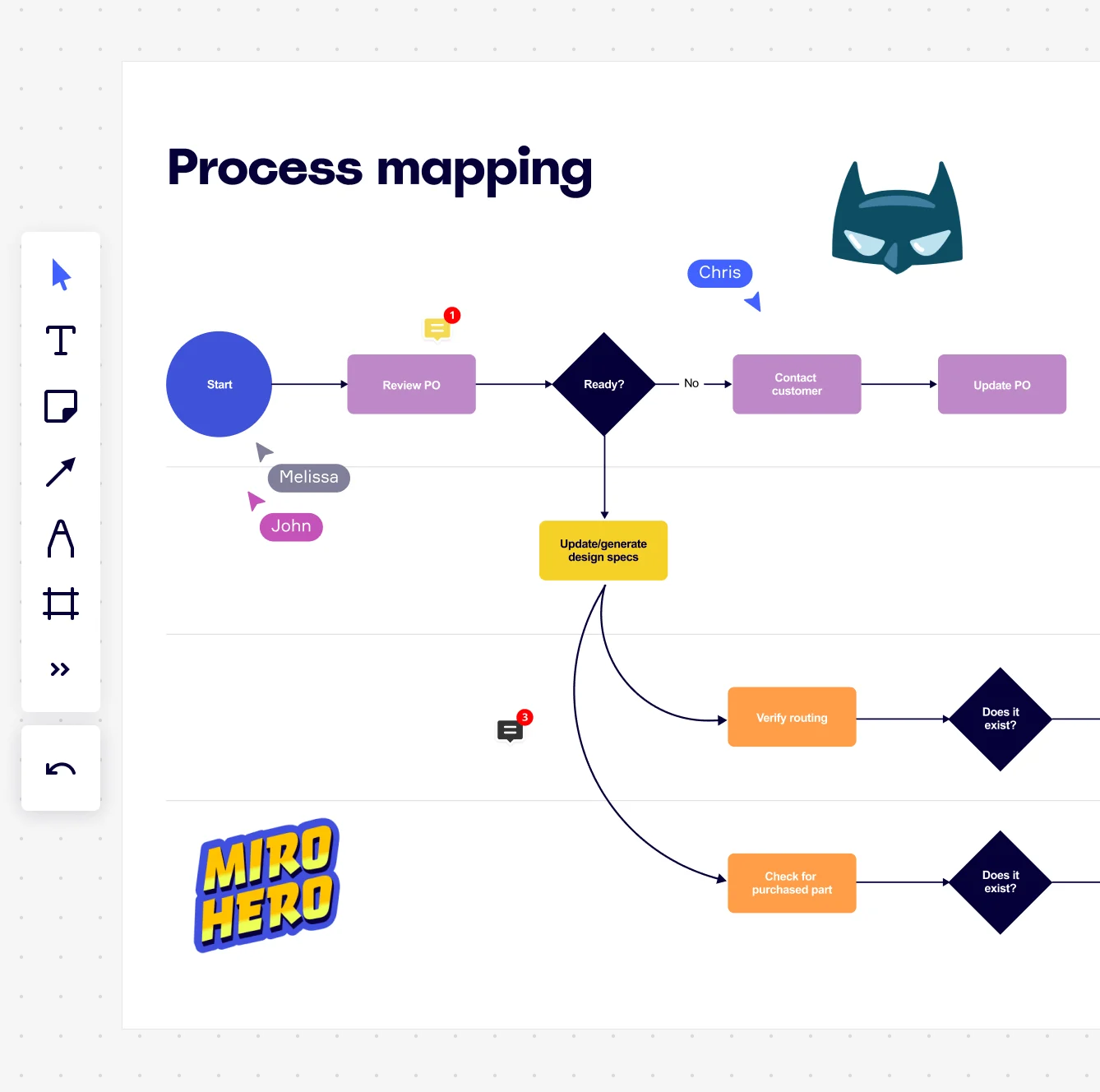
A Step by Step Guide: How to Create a Value Stream Map

Summary
In this guide, you will learn:
What VSM is and how it optimizes processes.
How to create a VSM using Miro's templates and tools.
Key VSM steps: select, add data, organize, analyze, and share.
Expert tips: use Lean Six Sigma (DMAIC) and Gemba walks.
Best practices for effective VSM: keep simple, standardize symbols, engage teams
How to sustain improvements: update, monitor, and foster continuous enhancement.
How to Create a Value Stream Map
Streamlining processes is vital for optimizing efficiency and achieving success. Value stream mapping is a powerful technique utilized across various domains, including engineering, UX, and more. It enables professionals to analyze and optimize the end-to-end series of activities required to deliver a product or service to customers.
In this expert-driven guide, we will explore the intricacies of value stream mapping, providing you with in-depth methodologies, practical techniques, and real-world case studies to help you master this essential tool.
Defining the Current and Future States
Before we delve into the steps of value stream mapping, let's define two fundamental concepts: the current state and the future state.
The current state represents the existing condition of your value stream, encompassing all the activities, processes, and information flow involved. It provides a snapshot of how things currently operate.
On the other hand, the future state refers to the desired state of your value stream after implementing improvements and optimizations. It represents the ideal flow, minimizing waste, reducing cycle times, and maximizing value-added activities.
The Steps for Creating a Value Stream Map
To create a value stream map, you can customize a pre-made template as a starting point, or map value streams from scratch using Miro's powerful diagram maker with its value stream mapping shape pack. Simply follow these steps.
Step 1: Define Your Value Stream
To begin your value stream mapping journey, it is crucial to define your value stream with precision. Identify the specific process or processes you wish to map out, whether it's the entire product lifecycle or a targeted workflow within your organization.
Clearly articulate the goals and objectives for mapping the value stream to ensure a focused and effective approach.
Step 2: Identify Value-Adding Activities
In this step, it is vital to identify the value-adding activities within your value stream. Value-adding activities are those that directly contribute to meeting customer needs and requirements.
By meticulously examining each step, you can differentiate between activities that create value and those that are non-value-adding or wasteful. This analysis forms the foundation for optimizing your processes.
Step 3: Analyze the Current State
Now, let's dive into the analysis of the current state of your value stream. It is crucial to thoroughly assess the existing process to identify bottlenecks, inefficiencies, and areas for improvement.
Utilize advanced methodologies such as time-motion studies, process flow analysis, and value analysis to gain a comprehensive understanding of the current state. By quantifying key metrics like cycle times, lead times, and resource utilization, you can pinpoint areas of waste and opportunity.
Step 4: Design the Future State
Having analyzed the current state, you are now ready to design the future state of your value stream. Collaborate with cross-functional teams and subject matter experts to brainstorm innovative ideas and potential improvements.
Utilize lean principles, such as the elimination of non-value-adding activities, the reduction of cycle times, and the optimization of resource allocation. Implementing these principles and incorporating best practices tailored to your specific industry will allow you to design an optimized and efficient future state.
Step 5: Implement and Monitor the Future State
With the future state defined, it is time to put your plan into action. Implement the changes identified during the previous steps while closely monitoring the impact of these changes.
Collect data and measure key performance indicators to evaluate the effectiveness of the new process. Continuously monitor, refine, and optimize the future state to ensure sustained improvements and ongoing success.
Expert Tips for Effective Value Stream Mapping
1. Utilize Value Stream Mapping Tools
Leverage specialized tools, such as Miro's value stream mapping tool, to create accurate and visually appealing value stream maps. These tools offer features such as drag-and-drop symbols, automated calculations, and the ability to simulate "what-if" scenarios, enabling more efficient analysis and decision-making.
2. Lean Six Sigma Methodologies
Integrate Lean Six Sigma methodologies into your value stream mapping process. Concepts such as DMAIC (Define, Measure, Analyze, Improve, Control) can provide a structured framework for continuous improvement, enabling you to identify root causes and implement effective solutions.
Miro has a DMAIC analysis template to help you get started.
3. Gemba Walks and Stakeholder Engagement
Conduct Gemba walks, which involve going to the actual workplace to observe and engage with employees. This hands-on approach allows you to gain valuable insights, foster collaboration, and build trust with stakeholders, ensuring a more accurate representation of the current state and facilitating smoother transitions to the future state.
Final Thoughts on Creating a Value Stream Map
Value stream mapping is a powerful tool for optimizing processes and enhancing productivity. By following the steps and incorporating expert techniques and methodologies, you can unlock the full potential of your value stream. Don't want to start from scratch? In Miro's template library, you'll find the value stream mapping template that suits your needs.
Remember to continuously monitor and refine your maps as processes evolve. Sustaining improvements requires fostering a culture of continuous improvement, providing ongoing training and support, monitoring performance metrics, and regularly reviewing and updating the value stream map. Engaging employees and empowering them to contribute to the improvement process is also vital for sustained success.
Author: Miro Team Last update: August 13, 2025